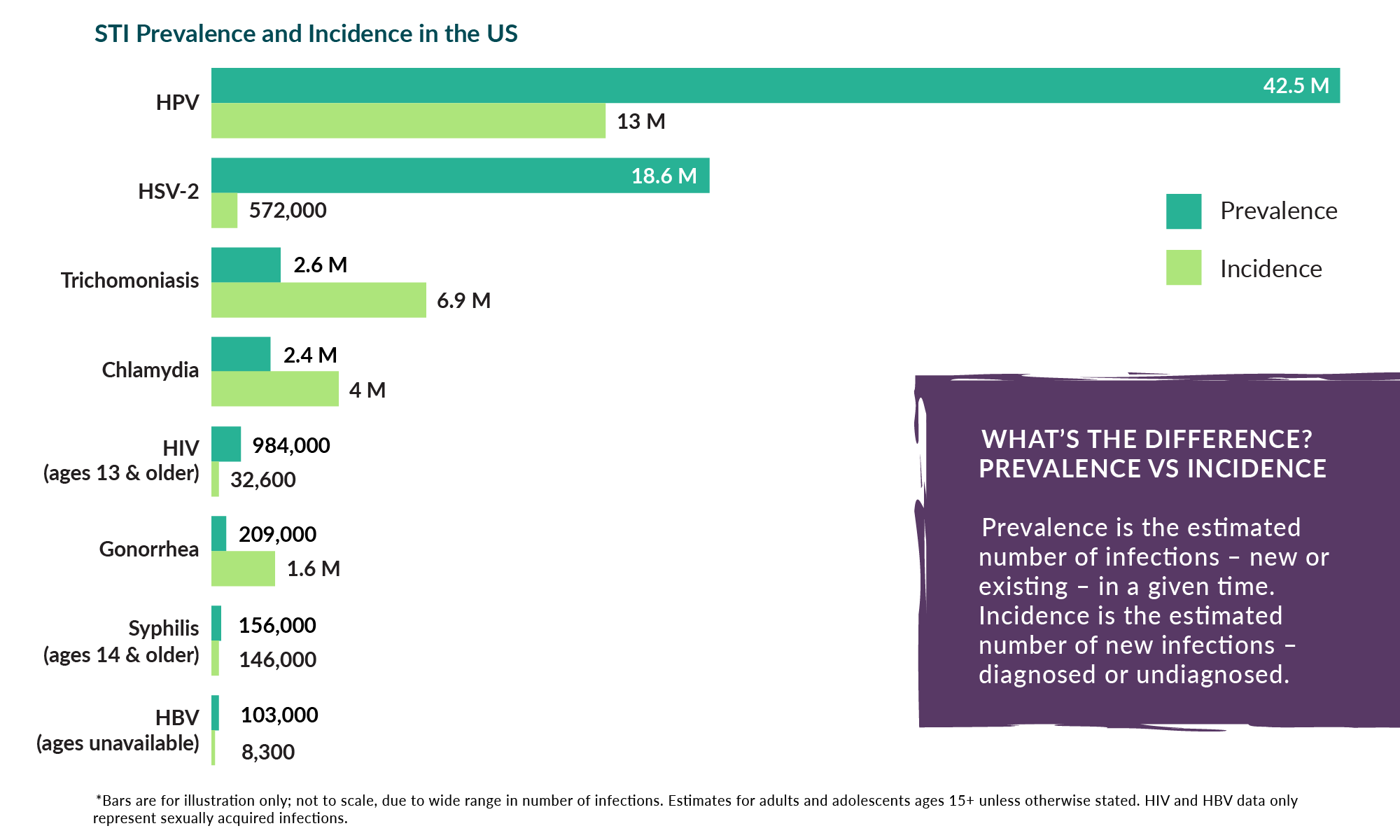Find out what STIs or STDs stand for!
Sexually transmitted infections (STIs) or Sexually transmitted diseases (STDs) are infections acquired by one person from another through sexual contact. They spread through intimate physical contact. Usually, the contact is vaginal, oral, or anal sex. Some STDs, like herpes and HPV, are spread from skin-to-skin contact.
STDs and STIs are very common. They are caused by bacteria, viruses, and certain parasites. Many people who possess them do not show any symptoms. Without treatment, STDs can lead to serious health issues. But the good news is that getting tested is no rocket science, and most STDs are easy to treat.
Want to know
Who gets affected?
STIs don’t always cause any symptoms. It is possible to get affected by sexually transmitted infections from people who seem perfectly in good health. They might not know that they have an infection. Most STDs affect both women and men, but in many cases, the problems they cause can be more severe for women. If a pregnant woman has an STI or STD, it can cause severe health problems for the baby.
How do you get affected?
The parasites that cause these infections and diseases get passed from one person to another in blood, semen, vaginal, and other bodily fluids. Sometimes these infections can be transmitted non-sexually. They can be transmitted from mothers to their infants during pregnancy or childbirth or through blood transfusions and shared needles.
Keep Yourselves and Your Friends Safe
STD Testing
Types of STDs/STIs
There are more than 20 types of STIs and STDs. The most common types of sexually transmitted diseases include:
Chlamydia – It is a very common STD caused by a bacterial infection. Often these don’t show any infection but Victims experience an odd discharge or pain while urinating. Chlamydia is very commonly reported in the U.S and is spread via oral, vaginal or anal sex. Chlamydia is easy to treat once diagnosed.
Gonorrhea – Gonorrhea is another common bacterial STD. People often contract it alongside Chlamydia. The symptoms of both these STDs are similar. Patients experience an unusual and odd-smelling discharge from the vagina or penis. Some even find it painful to urinate. Gonorrhea is easy to treat once diagnosed.
Syphilis – Syphilis is also a common STD that has afflicted numerous U.S citizens at large. It is set in four stages with the latent stage being the deadliest. It shows up as a painless rash in the genital or oral region and might often go unnoticed. These symptoms can get cured on their own after a while, but the virus remains dormant in the body for years. If left untreated, it can cause severe brain damage, blindness or in the worst cases even death.
Trichomoniasis – Trichomoniasis is a parasitic STD caused by the parasite, Trichomonas vaginalis. Studies prove that women are more likely to contract that disease than men. It is usually spread via sexual contact or intercourse. Symptoms of Trichomoniasis may include burning, itching, or sore genitals.
HIV & AIDS – HIV is the deadliest STD virus that can result in a life-threatening and incurable disease called AIDS. It can be transmitted via blood, genital or bodily fluids, and even breast milk. It directly attacks the immune system to a point where the victim’s body cannot stave off even minor infections.
Hepatitis B – It is a virus that can cause liver disease which spreads through sex or sharing personal hygiene items like toothbrushes or razors.
HCV (Hepatitis C) – It is a virus that can cause liver disease which spread by contact with contaminated blood; for example, from sharing needles or from unsterile tattoo equipment.
Genital Warts – These grow on the genital area and around the anus. They can be caused by certain types of HPV. These can be annoying but they aren’t dangerous and can be treated.
Herpes – Herpes is a commonly occurring STD amongst sexually active individuals in the U.S. Patients of Herpes may or may not experience genital blisters. Some symptoms may even go unnoticed due to these blisters appearing inside the vagina or anus. It is one of the most highly transmissive STDs. It can even be spread to individuals who have no sexual experience via skin-to-skin contact or if they come in contact with the bodily fluids of an infected individual.
Scabies – These are tiny parasites that cause irritation and itching. They are easily passed from one person to another through skin-to-skin contact, usually during sex. They can be cured.
Keep Yourselves and Your Friends Safe
Signs and Symptoms
What are Symptoms of STDs?
STIs and STDs have a wide range of signs and symptoms, including no symptoms. That’s why they may be overlooked until complications occur or your partner gets diagnosed. Different STDs have different symptoms. A few signs that might indicate you have an STI include:
- Sores or bumps on the genitals, oral or rectal area
- Painful or burning urination
- Discharge from the penis
- Unusual or odorous vaginal discharge
- Unusual vaginal bleeding
- Pain during sex
- Lower abdominal pain
- Fever and rash over the hands, trunk, or feet
Signs and symptoms may start to appear a few days after exposure. However, it may take several years before you start having any noticeable problems, depending on the organism causing the STI. Note that all of the above symptoms can be caused by things that aren’t STDs like pimples, UTIs, or yeast infections so to conform, getting tested is the only way to know what’s going on.
STDs Protection
When To Seek Medical Help?
It is very important to get tested if you think you have an STI or STD as some can cause severe health issues if you do not treat them on time. Having an STD makes you more likely to get other STDs, like HIV. It is for your good to find out right away if you have one, so you can avoid passing it on to other people. Most common STDs are easily curable with medicine and the ones that cannot be cured have treatments to help you with the signs and symptoms to lower your chances of passing it on to anyone else. So the sooner you know, the faster you can start taking care. Seek medical help immediately if:
- You are sexually active, especially with multiple partners
- Do you have any symptoms of having an STI or STD
STDs Testing Facility
Most of the time, STIs and STDs show no symptoms. Testing being the only way to know for sure if you have one, talk with a doctor or nurse about getting tested. If you’ve ever had any kind of sexual contact that can spread STIs and STDs like vaginal, anal, or oral sex, get tested and put your mind at ease.
Remember, you can’t tell you to have an STI just by the way you feel or look. Most people are asymptomatic. Even if you do not have any symptoms, you still need to get tested. It is very important to get tested if you’ve had unprotected sexual contact, or if you found out that your partner has one. A medical practitioner can tell you whether you should get tested. It is best if you find out as soon as possible. Some STIs and STDs can cause severe damage over time, even if you feel healthy right now. It can spread to others you have sex with whether or not you show any signs and symptoms.
The best part about getting tested is that it can put your mind at peace. Make STD testing a regular part of your life. Become responsible for taking care of yourself. Plus, getting tested at Affordable Rapid Testing is contactless, quick, and painless. Learn more about Sexually Transmitted Diseases (STDs).
Stay Safe
BE INFORMED ABOUT STDs And STIs
If you believe you have STI symptoms, conduct a test to confirm.
- Recurring Pain
- Fever
- Fatigue
- Memory Loss
- Weight Loss
- lumps or swellings


